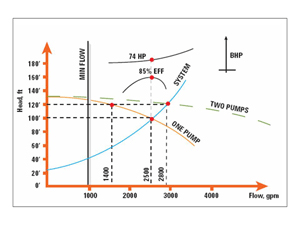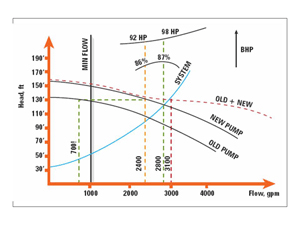Our repair shop manager, Jerry, asked me to accompany him on a trip to a power plant to determine the reason why a pump we had recently rebuilt was cavitating.
“Was it cavitating before the repair?” was my first question to him. “Not that I’m aware of,” Jerry answered, “although I do remember that they were talking about an upcoming system upgrade. However, I’m not sure what their exact plan was. I think they wanted to buy a bigger pump to gain more flow.”
Well then, I thought, we better get over there and see what was going on.
When we arrived at the plant, the rebuilt pump was running. Next to it was a brand new pump, sitting idle, with a tag that said “Do not operate, trips on amps.” The reliability engineer, Bill, told us that they had recently upgraded the system. Prior to that, they had two pumps in place and operated either one or both, depending on demand, as shown on Figure 1.

Figure 1. Two pumps operating in parallel, or individually, prior to the upgrade.
One pump delivered 2500-gpm. The two together delivered 2800-gpm. With a relatively small static head, the system curve reflected mostly friction losses in the pipes. The pump manufacturer’s curve stated the minimum flow to be approximately 1000-gpm, which was fine since each pump, when operating in parallel, was producing 1400-gpm, i.e. sufficiently above the MCSF (minimum continuous stable flow).
Each pump was coupled to a 75-hp motor. “We’ve never had any real problems with motors,” remarked Bill. “In fact, we have two spare motors so we don’t worry about buying new ones.” He winked and whispered, “That makes management happy, because our budget is tight this year.”
Bill explained to us that because they still needed to get more flow, they decided to purchase a bigger pump. “We do not understand why our two pumps do not double the flow. We can only go from 2500-gpm with one pump to 2800-gpm when running two pumps. Isn’t that strange?” he asked. “We would like to at least do better than 3000-gpm, so we figured a bigger pump was necessary to do the job. We purchased this new one sized for 2800-gpm, and hoped we could easily go over 3000-gpm with two running.”
As so often is the case, Jerry and I stood in front of the pumps with no available documentation (such as curves, drawings, etc.) to work with. I scribbled some quick calculations on paper, just to get a ballpark power estimate. The number I calculated was getting too close to the motor rating of 75-hp.
“Bill, let’s go to your office and take a look at the pump curve,” I advised. “I’m concerned with the motor power situation.” What we saw in Bill’s office is reproduced on Figure 1.
At 85 percent efficiency, the motor was drawing 74-hp, just below the nameplate rating. I asked Bill, “Did you realize that a new pump would need a bigger motor for more flow?” He responded that he had, in fact, considered that point. “But the pump manufacturer told me a bigger pump will be more efficient,” he remarked. “And doesn’t higher efficiency draw down the horsepower?”
Bill was right about the pump efficiency. A larger pump peaked at 87 percent, i.e. better than the older and smaller unit at 85 percent. But for the system curve they had, the pump head increased at higher flow to 120-ft, and, as shown in Figure 2, horsepower rose to 98-hp, despite the better efficiency.
I pointed this out to Bill. “No wonder we trip the breakers on amps and cannot run the new pump,” he said. “But why did this make the old pump sound funny?”
I asked Bill if he had time for a 15-minute crash course, and sketched out something similar to Figure 2.

Figure 2. The new (bigger pump) operates with the old (smaller pump), pushing it into the recirculation region. Besides that, it requires more power than the old motor can deliver, which causes the trip problem with amps.
“When your new big pump is running, it consumes too much power because you did not change the motor so you could use up the old 75-hp motors you had in stock. Well, you are using them up alright – by overloading. When you run your new pump together with an old smaller one, you get about 3100-gpm, which is above the 3000-gpm target (apparently a good thing!). But the stronger (bigger) pump is pushing the smaller one far to the left on a curve. It runs at 700-gpm, far below your MCSF flow of 1000-gpm.
What you hear is not cavitation, but low flow suction recirculation – and you are paying for that. Recirculation causes damage to the impeller that is similar to cavitation, and increased instabilities and vibration is nothing to right home about.”
“So, will a bigger motor help?” Bill asked, with hope in his voice. “Yes,” I replied, “but only to one part of the problem. You need to be above 100-hp. And probably with some safety margin to spare, perhaps 125-hp or so. But why did you buy a new pump to begin with, when the incremental flow you get is so small? Did you consider just slightly modifying the existing units?”
“Because we were told that this was the only way to get more flow,” answered Bill. “Besides, it’s hard to find parts for these old pumps. The manufacturer told us they are obsolete now anyway.” I wondered out loud, “Obsolete? Who obsoleted them? The casings still look good enough to outlive you and I! Pumps only get obsolete on paper – to make room for new sales. All you had to do, Bill, is make some small hydraulic modifications to your existing pumps, at a much smaller cost than stripping out the entire installation and repiping everything to a bigger pump. You’ve wasted lots of money . . . no wonder there is none left in your budget!”
“I would love to have the old units upgraded,” stated Bill, “Is there a lot involved?”
“Not really,” I said. “But before we take care of that, let’s review your system with a bit more attention and not rush into buying something new simply for the sake of buying it. As my grandmother said, ‘measure seven times, and cut once.’”
As a quiz to our readers, can you guess the type of upgrade the old pumps could have had to avoid purchasing a new pump and avoiding those costly piping changes? As always, the first three correct answers will qualify you for a free attendance at our next Pump School training session. Forward your answers to us via www.PumpingMachinery.com.
Pumps & Systems, October 2006

